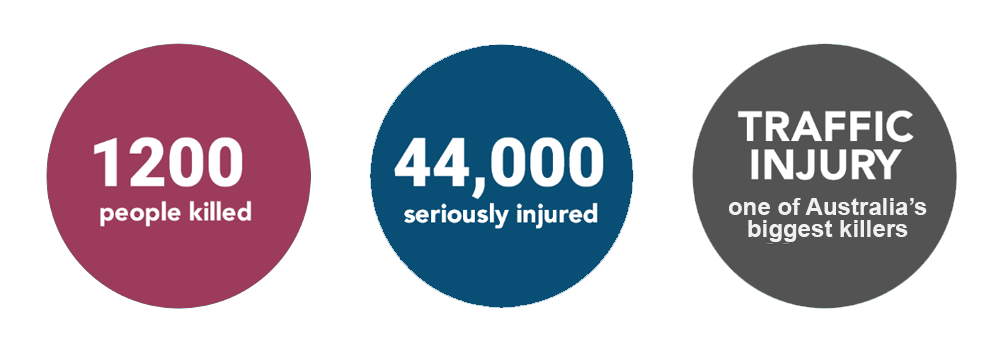

News
On Q: Honoring Australia’s National Road Safety Week
We’re proud to promote National Road Safety Week 2022 to raise awareness about road safety.
Every month, about 100 Australians die on the nation’s roads and more than 3,600 are injured. The tragedy doesn’t end there, however, as the ripple effect from these tragedies is as immeasurable as it is unimaginable. In fact, traffic accidents claim the most lives of children under 15 and is the second biggest killer of all Australians between the age of 15 and 24.

What began as a yellow ribbon initiative in May 2012, National Road Safety Week is now an 8-day event aimed to prevent death and serious injuries on Australian roadways. As purveyors of road safety equipment, such initiatives are always close to our heart.
This year, in honor of National Road Safety Week, we shed some light on the importance of work zone safety as part of the larger road safety equation.
Whether for temporary maintenance or an extended amount of time for construction, work zones are an essential piece of maintaining and upgrading our roadways. Yet, they present dangers for workers, motorists, and pedestrians alike – especially in the day and age of increasing driver distraction.
Did you know that when drivers aren’t paying attention, be it to answer the phone, change the radio, or even looking at the passenger next to them that they are 29 times more likely to be involved in a collision or near-collision in a highway work zone?
Work zones are not part of a driver’s regular commute and can easily catch them off-guard even in the best of circumstances. As with many road safety initiatives, the more advanced warning we can give motorists by means of things like route planning apps or in-vehicle alerts, the safer our roads become.
But, for most, managing work zone activities and related lane closures is ad-hoc, manual, and limited in scope – making work zone data challenging to manage and practically impossible to share.
This siloed nature, in conjunction with changing traffic patterns and narrowed roadways, creates a deadly combination of events that cause congestion and pollution, create driver and worker stress, and claim lives every day.
At Q-Free, we believe collecting data on the location, time, and impact of work zones in a standardized, distributable format is key to improving work zone safety. It’s also the purpose of the US Department of Transportation Work Zone Data Exchange.
Gathering work zone data
Sharing work zone data in a standardized format is necessary to improve work zone operations and safety. But as previously alluded to, all-too-often agencies do not have a sophisticated, yet easy to use, automated system for managing lane closures in the first place… so where will the data on work zone activities come from?
The answer could be your ATMS, smart work zone system, or integration with an automated lane closure management system, such as Q-Free’s LaneAware lane closure management tool.
LaneAware lane closure management tool
LaneAware is a sophisticated web-based tool that allows approved workers and contractors to request lane closure activities. Each request is automatically checked against user-defined business rules before being approved or flagged for further review. LaneAware also helps fulfill the need of “how” work zones will impact data when integrated with an ATMS, further supporting a work zone data feed.
Road and lane closures are an unavoidable aspect of building and maintaining road infrastructure. Efficient work zone management makes planning and implementing lane closures easier and more predictable for everyone.
An integrated, automated lane closure management tool allows agencies to:
- Coordinate ongoing road works and major projects with ease
- Share work zone data with the public and media
- Minimize errors and disruption to the commuting public
By providing a means to verify and compare multiple lane closures against well-defined policies and business practices, LaneAware helps to:
- Reduce the chance for duplicate requests
- Avoid conflicting project road closures
- Remove the potential of human error in scheduling
- Compile all lane closure data in one central database
- Minimize the impact to travelers
To boot, LaneAware alleviates the time and cost associated with manually tracking work events. And it allows agencies to share lane closure data with key stakeholders and the motoring public.
Taking it a step further
In addition to a web-based lane closure management tool for coordinating and approving lane closures, Q-Free offers additional solutions to mitigate congestion, manage incidents, and plan events with Q-Free’s Kinetic Mobility, which can assist with:
- Queue detection
- Incident and event management
- Managed lanes
- Hard shoulder running
- Variable speed limit
- Automated enforcement
- Coordinated signs and cameras
- Dynamic tolling
- CAD integrations
- and more…
Additional resources
National Road Safety Week
General Road Safety Stats & References
- Traffic management: Guide for construction work by Safe Work Australia April 2021
- Reviving Road Safety by Australian Automobile Association September 2019